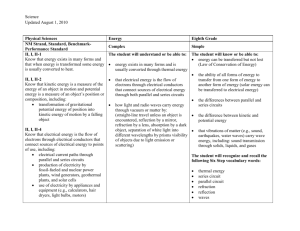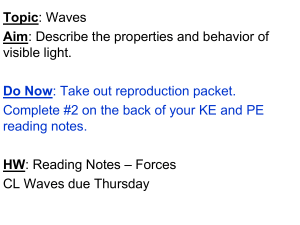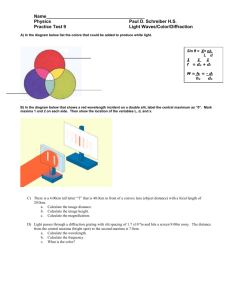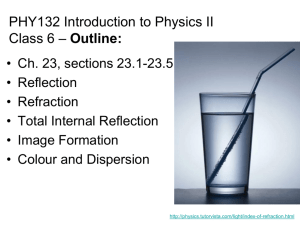What is Light?
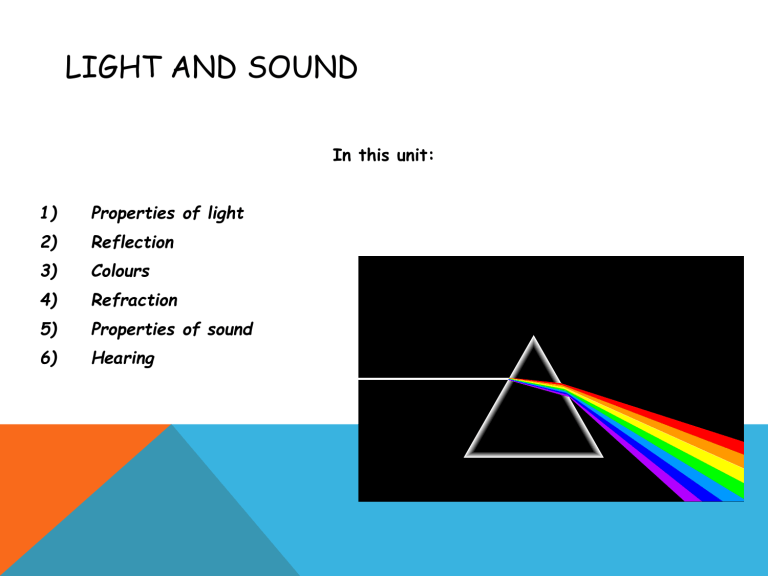
LIGHT AND SOUND
In this unit:
4)
5)
6)
1)
2)
3)
Properties of light
Reflection
Colours
Refraction
Properties of sound
Hearing
1/5/2015
What are some questions you have about light and color?
What is Light?
What causes it?
ELECTROMAGNETIC WAVES
Electromagnetic waves – light that travels as a photon through a vacuum or a medium in the form of radio, micro, visible light, or xrays
27.4
Light and Transparent Materials
Light is energy carried in an electromagnetic wave, generated by vibrating electric charges.
When light strikes matter, electrons in the matter are forced into vibration.
Frequency – number of waves per second – measured in hertz
Wavelength – distance from the same part of the wave
What is the relationship between wavelength and frequency
5/27
1. How are the electric field and magnetic field in an electromagnetic wave related to each other?
2. What causes light?
MEASURING VIBRATIONS
All waves are caused by vibrations
Frequency = vibrations / second
Frequency = cycles / second
measured in Hertz (Hz)
Period = time it takes to
Complete a cycle (s)
1 Hz = 1 cycle / second
Light travels VERY FAST – around
300,000 kilometres per second.
At this speed it can go around the world 8 times in one second.
SPEED OF LIGHT
27.2
The Speed of Light
Light coming from Io takes longer to reach
Earth at position D than at position A. The extra distance that the light travels divided by the extra time it takes gives the speed of light.
Light year – distance light travels in one year
27.8
Polarized Light and 3-D Viewing
Try these optical illusions.
27.8
Polarized Light and 3-D Viewing
27.8
Polarized Light and 3-D Viewing
1. Recall that it takes one billion nanometers to equal one meter. Preform the following conversions
6.25*10 -7 m = __________ nm
520 nm = _________ m
2. What is the relationship between frequency and wavelength? C = f *λ
3. How many nanometers are in a meter?
DAILY OBJECTIVES:
-MEASURE THE ANGLE OF INCIDENCE AND THE ANGLE OF REFRACTION TO
DETERMINE THE INDEX OF REFRACTION
- ADVANCED : CALCULATE THE SPEED OF LIGHT IN GLASS
1/6
Warm up
1. What causes the pencil to appear bent when it sits in water?
2. What happens to the appearance of the small beaker when emerged in canola oil?
Refraction – the bending of light when it passes from one medium to the other.
Snell ’ s law
N1Sin θ
1
= N
2
Sin θ
2
N = sin i / sin r
N = index of refraction, which is the ratio of the speed of light in a vacuum to the speed of light in the substance
N = C / velocity in substance
C = speed of light in a vacuum = 3 *10^8
1/7
Recall that the index of refraction is N = speed of light in vacuum/ speed of light in substance.
What does it mean if the n is less that 1?
1/8 AGENDA : LIGHT REVIEW
FINISH LAB
Percentage error = (experimental – theoretical) / theoretical
Index of refraction = speed of light in a vacuum / in a substance
1. If the book value for the index of refraction is 1.33 and your measured value is 1.20, what is your percentage error?
2. What are some applications of snells law
3. What happens to the speed of light when in reaches a more dense medium
WHO MIGHT USE THE PROPERTY OF
REFRACTION?
http://interactagram.com/physics/optics/refraction/
The light rectangle represents the apparent position of the pencil. Notice that the end
(X) looks like it is at (Y), a position that is considerably shallower than (X).
As the light goes from the water to the air does its velocity increase or decrease?
CAN YOU THINK OF SOME TECHNICAL
APPLICATIONS FOR SNELL
’
S LAW?
WHAT CAUSES A MIRAGE
As light approaches the hotter air near the ground it bends away from the normal
6/2
Why are diamonds so shinny?
Why might it be useful to know a materials index of refraction?
What are some applications of Snell’s law?
Finish CER
SNELL’S LAW CONCLUSION
Claim – what did you find in your experiment
Evidence – Use your picture and calculations for this. How close to 1.33 where your measurements, you can use percentage error calculations in these.
[1.33– measured value] / 1.33
Reasoning – How does your experiment show refraction. What are some possible errors. Use vocabulary like angle of incidence, angle of reflection and normal to describe what is happening
http://www.youtube.com/watch?v=blnL6z3teUE - computer simulation of a diamond http://www.youtube.com/watch?v=dWwQqI2BkVc - Snell’s laws song
Singin’ n1 sine theta-sub1 hey, hey hey
Equals n2 sine theta –sine sub 2 hip hip hooray
29.8
Refraction of Light a.
The apparent depth of the glass block is less than the real depth. b.
The fish appears to be nearer than it actually is. c.
The full glass mug appears to hold more root beer than it actually does.
These effects are due to the refraction of light whenever it crosses a boundary between air and another transparent medium.
27.2
The Speed of Light
The speed of light in a vacuum is a universal constant.
Light is so fast that if a beam of light could travel around Earth, it would make 7.5 trips in one second.
Light takes 8 minutes to travel from the sun to Earth and 4 years from the next nearest star, Alpha Centauri.
The distance light travels in one year is called a light-year.
27.7
Polarization
If the rope is shaken up and down, a vertically polarized wave is produced.
The waves traveling along the rope are confined to a vertical plane.
If the rope is shaken from side to side, a horizontally polarized wave is produced.
27.8
Polarized Light and 3-D Viewing
A 3-D slide show uses polarizing filters. The left eye sees only polarized light from the left projector; the right eye sees only polarized light from the right projector.
27.7
Polarization
A vibrating electron emits a polarized electromagnetic wave.
A vertically vibrating electron emits vertically polarized light.
A horizontally vibrating electron emits horizontally polarized light.
27.7
Polarization
A rope analogy illustrates the effect of crossed sheets of polarizing material.
27.7
Polarization a.
Light is transmitted when the axes of the polarizing filters are aligned. b.
Light is absorbed when they are at right angles to each other.
POLARIZATION
5/16
What are some differences between light and sound?
What is one thing you learned from your classmates yesterday?
5/17
True or false black is a combination of all the colors
What do you see below?
Why is candle light more romantic?
1/9
1. The color green has a wavelength of
520 nanometers, what is its wavelength in meters? (hint I meter =
1,000,000,000 or one billion nanometers)
2. Write this number in scientific notation.
1/10
Draw a picture and write a formula for each of the problems
1.
The mass of one hydrogen atom is 1.67 * 10 -27 kg. A cylinder contains 3 * 10 23 atoms. What is the mass of the atoms?
2.
The average distance from the Earth to the sun is 1.5
*10 11 m. The speed of light is 3*10 8 m/s. How long does it take for light to travel from the sun to the earth?
Exponent rules
When multiplying scientific notation add exponents
When dividing subtract exponents
Hint for Physics fix 30 s= d/t what are the other two?
1/15
1. List the types of waves on the electromagnetic spectrum from lowest frequency to highest frequency.
2. Radio waves travel at the speed of light at 300,000 km per second. The Frequency of the radio wave is 150 mega hertz. What is the wavelength? ( hint mega=
1,000,000 kilo= 1,000) wave speed = frequency * wavelength)
1. Test today
1/15
1. List the types of waves on the electromagnetic spectrum from lowest frequency to highest frequency.
2. Radio waves travel at the speed of light at 300,000 km per second. The Frequency of the radio wave is 150 mega hertz. What is the wavelength? ( hint mega=
1,000,000 kilo= 1,000)
3. wave speed = frequency * wavelength)
4. Test tomorrow
C = frequency * wavelength wave speed = wavelength x frequency v = λ x f
C= F * λ
C = is speed of light 3* 10^8
F = frequency = vibrations per second measured in hertz
Λ ( greek letter lambda) Wavelength = measured in meters
Light is measured in namometers.
What determines the color something is?
Why does yellow feel cool in the summer?
Yellow is the light from the sun that is reflected back, what is not reflected is absorbed so this is why black feels the warmest in the summer.
Ozone – blocks harmful UV rays
Why the sky is blue
Blue light is absorbed and then scattered
The colors of the objects depend on the color of the light that illuminates them.
Color is in the eye of the beholder and is provoked by the frequencies of light emitted or reflected by things. We see red in a rose when light of certain frequencies reaches our eyes.
Many organisms, including people with defective color vision, see no red in a rose.
COLOR
The colors of the objects depend on the color of the light that illuminates them.
Color depends on the wavelength that is reflected back.
28.1
The Color Spectrum
Isaac Newton was the first to make a systematic study of color.
Passing sunlight through a glass prism, Newton showed that sunlight is composed of a mixture of all the colors of the rainbow.
Newton called this spread of colors a spectrum, and noted that the colors were formed in the order red, orange, yellow, green, blue, and violet.
What is the jist of this passage?
28.1
The Color Spectrum
When sunlight passes through a prism, it separates into a spectrum of all the colors of the rainbow.
1/16
1. Compare gamma rays to radio waves.
a. Which one has a greater frequency?
b. Which one has a greater wavelength?
c. Where is each one found?
2. What is the wavelength of a radio wave that has a frequency of 10 Hz?
Due today – snell’s law lab
Notebook check 1/8 – 1/16
28.2
Color by Reflection
Light Sources
The color of an object depends on the kind of light used.
• A candle flame is deficient in higher frequencies; it emits a yellowish light. Things look yellowish in candlelight.
• An incandescent lamp emits light of all the visible frequencies, but is richer toward the lower frequencies, enhancing the reds.
• A fluorescent lamp is richer in the higher frequencies, so blues are enhanced when illuminated with fluorescent lamps.
• Do you think you look better in certain light?
• Why is candle light more romantic?
28.2
Color by Reflection a.
This square reflects all the colors illuminating it. In sunlight, it is white.
When illuminated with blue light, it is blue. b.
This square absorbs all the colors illuminating it. In sunlight it is warmer than the white square.
28.4
Sunlight
The radiation curve of sunlight is a graph of brightness versus frequency.
Sunlight is brightest in the yellow-green region.
Mini lab:
Which folder will be brighter under red light, blue or red?
Which folder will be brighter under blue light, blue or red?
Expain:
28.5
Mixing Colored Light
The low-frequency, middle-frequency, and high-frequency parts of white light appear red, green, and blue.
To the human eye, red + green = yellow; red + blue = magenta; green + blue = cyan.
28.6
Complementary Colors
Six blocks and their shadows appear as different colors depending on the color of light that illuminates them.
28.2
Color by Reflection
Petals of most yellow flowers, such as daffodils, reflect red and green as well as yellow.
Yellow daffodils reflect light of a broad band of frequencies.
The reflected colors of most objects are not pure single-frequency colors, but a spread of frequencies.
So something yellow, for example, may simply be a mixture of colors without blue and violet—or it can be red and green together.
Main idea : The color you see is a combination of frequencys that are reflected back into your eye.
WHY IS THE SKY BLUE
Why is the sky blue?
Sunlight reaches Earth's atmosphere and is scattered in all directions by all the gases and particles in the air. Blue light is scattered in all directions by the tiny molecules of air in Earth's atmosphere. Blue is scattered more than other colors because it travels as shorter, smaller waves. This is why we see a blue sky most of the time.
WHAT MAKES A RED SUNSET?
28.8
Why the Sky Is Blue
The sky is blue because its component particles scatter high-frequency light.
28.8
Why the Sky Is Blue or black
The higher that one goes into the atmosphere, the fewer molecules there are in the air to scatter light.
The sky appears darker.
When there are no molecules, as on the moon, for example, the “ sky ” is black.
LAW OF REFLECTION
THE ANGLE OF INCIDENCE = THE ANGLE OF
REFLECTION
Refraction – the bending of light due to a change in light speed
Coming up next on
Monday snell’s law
Which topic did you choose?
What is the main idea behind your topic?
Today –
-present your findings to classmate
-Fill out exit slip
5/15
Are you ready to present?
What are some characteristics of a strong presentation?
Exit slip – write a paragraph reflection on how you did.
What was the main idea. What extra information did you have. Rate yourself 1-5. What did you do well, what could use work?
5/16
1. What is one thing you learned from your classmates regarding light?
Light travels much faster than sound. For example:
1) Thunder and lightning start at the same time, but we will see the lightning first.
2) When a starting pistol is fired we see the smoke first and then hear the bang.
PROPERTIES OF LIGHT SUMMARY
1) Light travels in straight lines
2) Light travels much faster than sound
3) We see things because they reflect light into our eyes
4) Shadows are formed when light is blocked by an object
We see things because they reflect light into our eyes:
Homework
SEEING COLOUR
The colour an object appears depends on the colours of light it reflects.
For example, a red book only reflects red light:
White light
Only red light is reflected
ADDING COLOURS
White light can be split up to make separate colours. These colours can be added together again.
The primary colours of light are red, blue and green: makes magenta
(purple)
Adding blue and green makes cyan
(light blue)
Adding red and green makes yellow
Adding all three makes white again
A pair of purple trousers would reflect purple light
(and red and blue, as purple is made up of red and blue):
Purple light
A white hat would reflect all seven colours:
White light
In different colours of light this kit would look different:
Red light
Shirt looks red
Shorts look black
Shirt looks black
Blue light
Shorts look blue
PART 2 - REFLECTION
Reflection from a mirror:
Normal
Incident ray
Angle of incidence
Angle of reflection
Reflected ray
Mirror
The Law of Reflection
Angle of incidence = Angle of reflection
In other words, light gets reflected from a surface at ____ _____ angle it hits it.
The same !!!
CLEAR VS. DIFFUSE REFLECTION
Smooth, shiny surfaces have a clear reflection:
Rough, dull surfaces have a diffuse reflection.
Diffuse reflection is when light is scattered in different directions
5/22
1. The color green has a wavelength of
520 nanometers, what is its wavelength in meters? (hint I meter =
1,000,000,000 or one billion nanometers)
2. Write this number in scientific notation.
6 TH HOUR ASSIGNED SEATS
1. Recall that it takes one billion nanometers to equal one meter.
Preform the following conversions
6.25*10 -7 m = __________ nm
520 nm = _________ m
Why is the sky blue?
Agenda
Physics fix 30
29.10
Dispersion in a Prism
Dispersion through a prism occurs because different frequencies of light travel at different speeds.
COLOUR
White light is not a single colour; it is made up of a mixture of the seven colours of the r a i n b o w .
We can demonstrate this by splitting white light with a prism:
This is how rainbows are formed: sunlight is up ” by raindrops.
“ split
THE COLORS OF THE RAINBOW:
Red
Orange
Yellow
Green
Blue
Indigo
Violet
29.11
The Rainbow
Dispersion of sunlight by a water drop produces a rainbow.
29.11
The Rainbow
Light from droplets inside the rainbow form a bright disk with the colored rainbow at its edge. The sky appears darker outside the rainbow because there is no light exiting raindrops in the way that produces the main rainbow.
29.11
The Rainbow think!
If light traveled at the same speed in raindrops as it does in air, would we still have rainbows?
29.12
Total Internal Reflection a-d. Light emitted in the water at angles below the critical angle is partly refracted and partly reflected at the surface. e. At the critical angle, the emerging beam skims the surface. f. Past the critical angle, there is total internal reflection.
29.12
Total Internal Reflection
Optical Fibers
Optical fibers, sometimes called light pipes, are transparent fibers that pipe light from one place to another.
They do this by a series of total internal reflections.
Optical fibers are useful for getting light to inaccessible places.
Mechanics and machinists use them to look at the interiors of engines, and physicians use them to look inside a patient ’ s body.
29.11
The Rainbow think!
If light traveled at the same speed in raindrops as it does in air, would we still have rainbows?
Answer:
No. If there is no change in speed, there is no refraction. If there is no refraction, there is no dispersion of light and hence, no rainbow!
Assessment Questions
1.
Scientists now agree that light is composed of a. only electromagnetic waves.
b. only photons.
c. electromagnetic waves and particles called photons.
d. an unknown source.
Assessment Questions
1.
Scientists now agree that light is composed of a. only electromagnetic waves.
b. only photons.
c. electromagnetic waves and particles called photons.
d. an unknown source.
Answer: C
Assessment Questions
3.
All of the following are part of the electromagnetic spectrum EXCEPT a. light.
b. sound.
c. radio waves.
d. X-rays.
Assessment Questions
3.
All of the following are part of the electromagnetic spectrum EXCEPT a. light.
b. sound.
c. radio waves.
d. X-rays.
Answer: B
Assessment Questions
5.
Light that is not transmitted by opaque materials is a. converted to internal energy in the material.
b. mainly reflected.
c. mainly refracted.
d. transmitted at a lower frequency.
Assessment Questions
5.
Light that is not transmitted by opaque materials is a. converted to internal energy in the material.
b. mainly reflected.
c. mainly refracted.
d. transmitted at a lower frequency.
Answer: A
Assessment Questions
8.
The best way to view something in 3-D is to a. have keen eyesight.
b. use two eyes.
c. use only one eye.
d. be slightly cross-eyed.
Assessment Questions
8.
The best way to view something in 3-D is to a. have keen eyesight.
b. use two eyes.
c. use only one eye.
d. be slightly cross-eyed.
Answer: B
Assessment Questions
2.
To say that rose petals are red is to say that they a. absorb red.
b. reflect red.
c. emit red.
d. transmit red.
Assessment Questions
2.
To say that rose petals are red is to say that they a. absorb red.
b. reflect red.
c. emit red.
d. transmit red.
Answer: B
Assessment Questions
8.
The blueness of the daytime sky is due mostly to light a.
absorption.
b.
transmission.
c.
reflection.
d.
scattering.
Assessment Questions
8.
The blueness of the daytime sky is due mostly to light a.
absorption.
b.
transmission.
c.
reflection.
d.
scattering.
Answer: D
Assessment Questions
6.
Refraction occurs when a wave crosses a boundary and changes a. speed and direction.
b. intensity.
c. frequency.
d. amplitude.
Assessment Questions
6.
Refraction occurs when a wave crosses a boundary and changes a. speed and direction.
b. intensity.
c. frequency.
d. amplitude.
Answer: A
1. How does your TV screen make every color?
2. What happens to light when it goes from a more dense medium into a less dense medium? a. Speeds up and goes towards normal b. Speeds up and goes away from normal c. Slows down up and goes towards normal d. Slows down up and goes away from normal
3. Are you ready for the quiz?
Notebook check # of dates from 5/13



